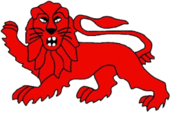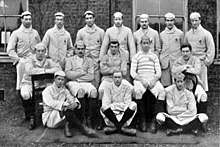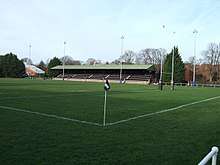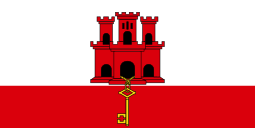Cambridge University R.U.F.C.
The Cambridge University Rugby Union Football Club, sometimes abbreviated "CURUFC", is the rugby union club of the University of Cambridge. The team plays Oxford University RFC in the annual Varsity Match at Twickenham Stadium every December.
 | ||
| Full name | Cambridge University Rugby Union Football Club | |
|---|---|---|
| Union | RFU | |
| Nickname(s) | Blues | |
| Founded | 1872 | |
| Location | Cambridge, England | |
| Ground(s) | University Football Ground, Grange Road (Capacity: 1,500) | |
| ||
| Official website | ||
| www | ||
Cambridge players wear light blue and white hooped jerseys with a red lion crest. Many have gone on to represent their country and the British and Irish Lions; a few, most notably Dan Vickerman, James Horwill & Flip van der Merwe, have represented Cambridge after successful international careers. While at Cambridge University James Bevan became the first captain of the Wales national rugby union team. The CURUFC stadium is located in West Cambridge, beside Grange Road.
History

Football is believed to have been introduced to Cambridge University in 1839 by Trinity College fresher Albert Pell.[1] Pell had matriculated at Cambridge after going up from Rugby School, where the game of rugby is believed to have originated. Cambridge University Rugby Union Football Club was officially established in 1872, around three years after the Oxford rugby club was founded. The first Varsity match was contested between the two teams on 10 February 1872.[2] The Cambridge team was led out by captain Isaac Cowley Lambert, wearing pink jerseys with a monogram on the left breast.[2] Played away at the Park in Oxford, Cambridge lost by a single goal to nil. CURUFC officials helped to draw up the laws of the game that were adopted by the Rugby Football Union (RFU) when it was established in 1871. Cambridge became a Constituent Body of the Union in 1872, a status which the club still holds today. In 1874, Cambridge provided their first international player directly from the club, when John Batten represented England in the third encounter against Scotland.
Facilities
Ground

The CURUFC Stadium and Training Grounds are located in West Cambridge, close to Selwyn College's Cripps Court and St Catherine's College's St Chad building. The historic stadium features a number of buildings dating to the early 19th and 20th centuries. A large red lion, a symbol of the University of Cambridge, stands guard beside the stadium. The facilities are partially maintained by Cantab Asset Management. The stadium, built in the 19th century, is undersized and is often over capacity during matches, leading to calls for an expansion and redevelopment project. In addition to the Grange Road Site, the club practices on various college and university fields around Cambridge and Grantchester.
Redevelopment Project
In 2015, plans were drafted for a large redevelopment of the Grange Road Site which would ensure the team remains competitive over the next 50 years. The plans included expanded seating, high-tech training facilities, and a new walled admission entrance on Grange Road. An architect for the project has yet to be chosen. In Michaelmas 2017, the CURUFC launched its first fundraising campaign for the Grange Road Redevelopment Project.
Notable former players
British and Irish Lions
The following former players were selected for the British and Irish Lions touring squads while playing for Cambridge University.
- Carl Aarvold 1930
- Randolph Aston 1891
- David Bedell-Sivright 1903, 1904
- Sydney Pyman Bell 1896
- J.H. Bordass 1924
- Harry Bowcott 1930
- Edward Bromet 1891
- William Cave 1903
- Granville Coghlan 1927
- Mike Gibson 1966
- Thomas Alexander Gibson 1903
- Johnny Hammond 1891
- Alfred Hind 1903
- Herbert Laxon 1908
- Alun Lewis 1977
- Osbert Mackie 1896
- Edwin Mayfield 1891
- William Grant Mitchell 1891
- Arthur Rotherham 1891
- Clement Pearson Simpson 1891
- Ken Scotland 1959
- Arthur Smith 1955
- Aubone Surtees 1891
- Willie Thomas 1888
- Robert Thompson 1891
- William Henry Thorman 1891
- G. H. Waddell 1959
- William Wotherspoon 1891
International players
The following former players represented a national team while playing for Cambridge University:



.svg.png)


.svg.png)








.svg.png)












.svg.png)


The following Cambridge players won international honours before playing for Cambridge:
.svg.png)
.svg.png)

.svg.png)

Honours
- Melrose Sevens
- Champions (1): 1960
Bibliography
- Marshall, Howard; Jordon, J.P. (1951). Oxford v Cambridge, The Story of the University Rugby Match. London: Clerke & Cockeran.
References
- Marshall (1951), pg 13.
- Marshall (1951), pg 17.
